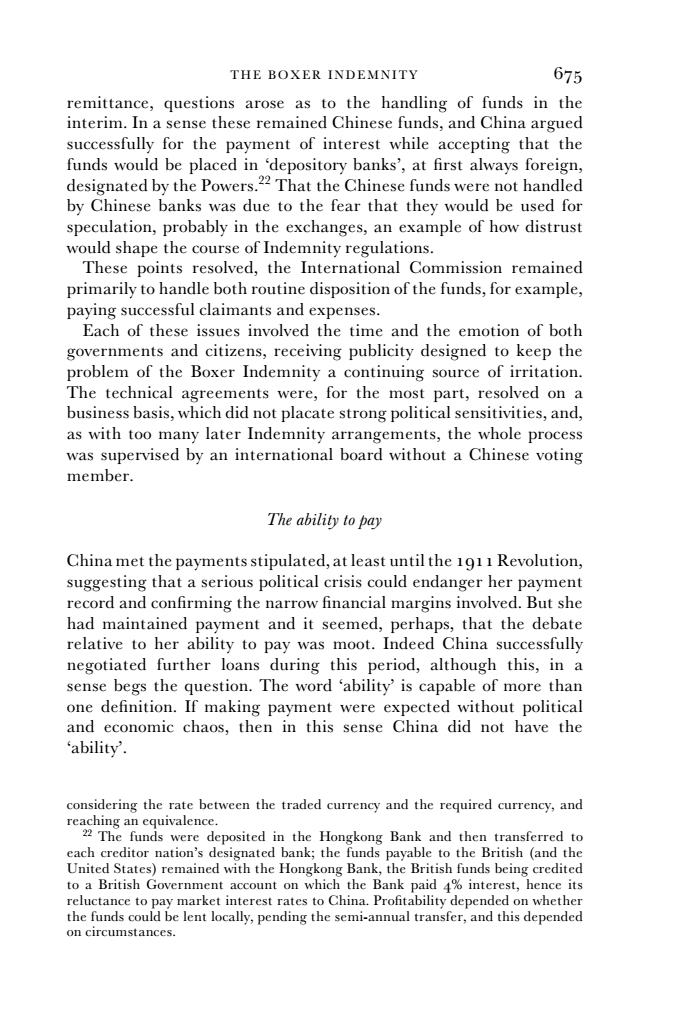正在加载图片...

THE BOXER INDEMNITY 675 remittance,questions arose as to the handling of funds in the interim.In a sense these remained Chinese funds,and China argued successfully for the payment of interest while accepting that the funds would be placed in 'depository banks',at first always foreign, designated by the Powers.22 That the Chinese funds were not handled by Chinese banks was due to the fear that they would be used for speculation,probably in the exchanges,an example of how distrust would shape the course of Indemnity regulations. These points resolved,the International Commission remained primarily to handle both routine disposition of the funds,for example, paying successful claimants and expenses. Each of these issues involved the time and the emotion of both governments and citizens,receiving publicity designed to keep the problem of the Boxer Indemnity a continuing source of irritation. The technical agreements were,for the most part,resolved on a business basis,which did not placate strong political sensitivities,and, as with too many later Indemnity arrangements,the whole process was supervised by an international board without a Chinese voting member. The ability to pay China met the payments stipulated,at least until the 1911 Revolution, suggesting that a serious political crisis could endanger her payment record and confirming the narrow financial margins involved.But she had maintained payment and it seemed,perhaps,that the debate relative to her ability to pay was moot.Indeed China successfully negotiated further loans during this period,although this,in a sense begs the question.The word 'ability'is capable of more than one definition.If making payment were expected without political and economic chaos,then in this sense China did not have the ability'. considering the rate between the traded currency and the required currency,and reaching an equivalence. 22 The funds were deposited in the Hongkong Bank and then transferred to each creditor nation's designated bank;the funds payable to the British (and the United States)remained with the Hongkong Bank,the British funds being credited to a British Government account on which the Bank paid 4%interest,hence its reluctance to pay market interest rates to China.Profitability depended on whether the funds could be lent locally,pending the semi-annual transfer,and this depended on circumstances.THE BOXER INDEMNITY 675 remittance, questions arose as to the handling of funds in the interim. In a sense these remained Chinese funds, and China argued successfully for the payment of interest while accepting that the funds would be placed in ‘depository banks’, at first always foreign, designated by the Powers.22 That the Chinese funds were not handled by Chinese banks was due to the fear that they would be used for speculation, probably in the exchanges, an example of how distrust would shape the course of Indemnity regulations. These points resolved, the International Commission remained primarily to handle both routine disposition of the funds, for example, paying successful claimants and expenses. Each of these issues involved the time and the emotion of both governments and citizens, receiving publicity designed to keep the problem of the Boxer Indemnity a continuing source of irritation. The technical agreements were, for the most part, resolved on a business basis, which did not placate strong political sensitivities, and, as with too many later Indemnity arrangements, the whole process was supervised by an international board without a Chinese voting member. The ability to pay China met the payments stipulated, at least until the 1911Revolution, suggesting that a serious political crisis could endanger her payment record and confirming the narrow financial margins involved. But she had maintained payment and it seemed, perhaps, that the debate relative to her ability to pay was moot. Indeed China successfully negotiated further loans during this period, although this, in a sense begs the question. The word ‘ability’ is capable of more than one definition. If making payment were expected without political and economic chaos, then in this sense China did not have the ‘ability’. considering the rate between the traded currency and the required currency, and reaching an equivalence. 22 The funds were deposited in the Hongkong Bank and then transferred to each creditor nation’s designated bank; the funds payable to the British (and the United States) remained with the Hongkong Bank, the British funds being credited to a British Government account on which the Bank paid 4% interest, hence its reluctance to pay market interest rates to China. Profitability depended on whether the funds could be lent locally, pending the semi-annual transfer, and this depended on circumstances